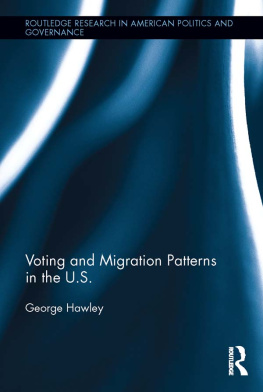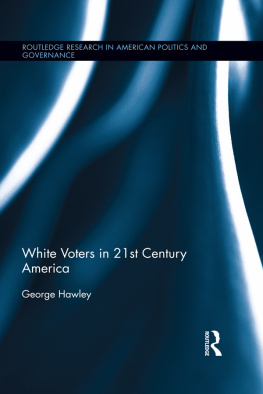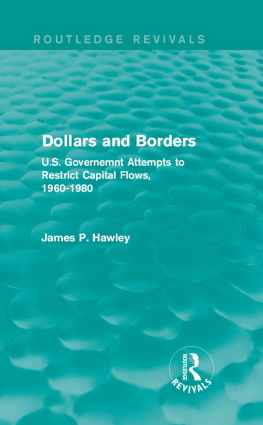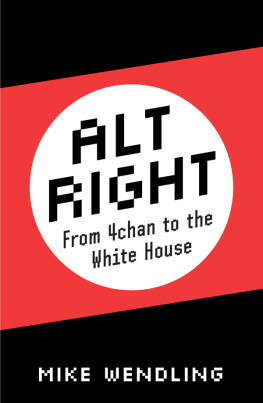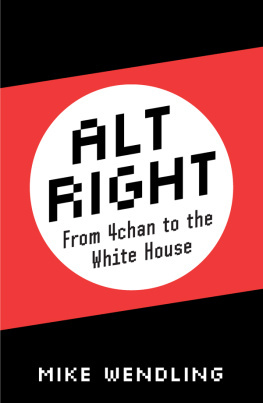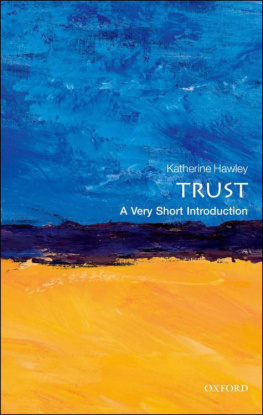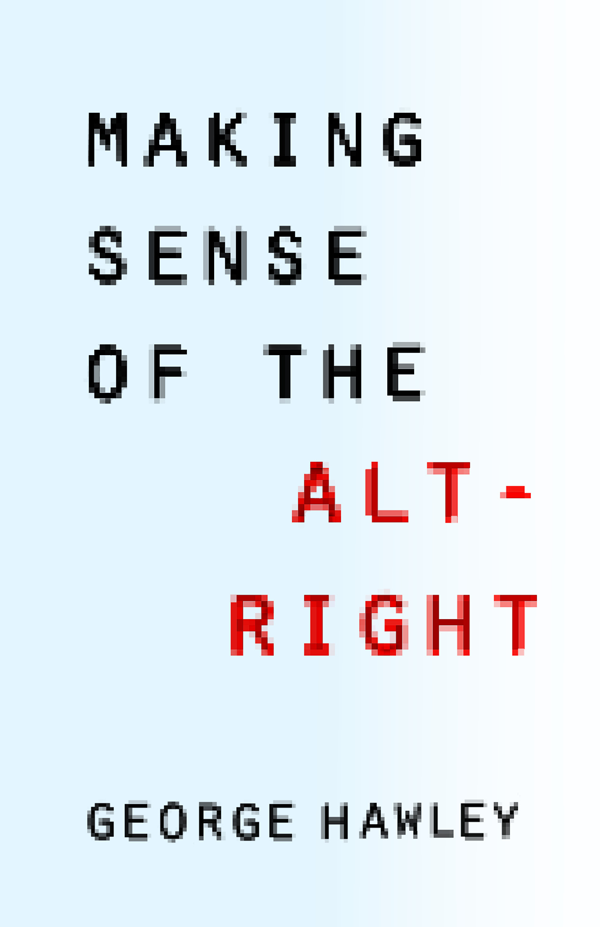Contents
Guide
Pagebreaks of the print version
MAKING SENSE OF THE
ALT-RIGHT
MAKING SENSE OF THE
ALT-RIGHT
GEORGE HAWLEY
COLUMBIA UNIVERSITY PRESS | NEW YORK
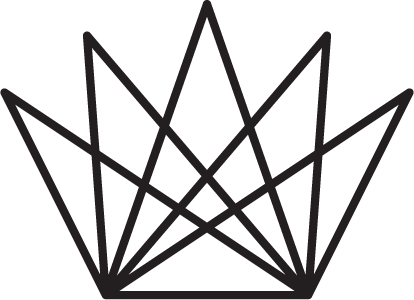
Columbia University Press
Publishers Since 1893
New York Chichester, West Sussex
cup.columbia.edu
Copyright 2017 Columbia University Press
All rights reserved
E-ISBN 978-0-231-54600-3
Library of Congress Cataloging-in-Publication Data
A complete CIP record is available from the Library of Congress
ISBN 978-0-231-18512-7 (cloth : alk. paper)
A Columbia University Press E-book.
CUP would be pleased to hear about your reading experience with this e-book at .
Cover design: Noah Arlow
For Nina
CONTENTS
I am grateful to the many patient and generous people who helped me complete this book. As always, I thank the University of Alabama for keeping me employed and allowing me the freedom to pursue my various research interests. I especially thank Joseph Smith, the chair of the political science department, who has been unfailingly supportive.
I owe a special thanks to Bridget Flannery-McCoy, my editor at Columbia University Press. Throughout this process, she has been helpful and encouraging. I have worked with many academic presses throughout my career but never before benefited from such a hands-on and hardworking editor. I am also grateful to my friend Jesse Merriam of Loyola University, who read an early draft of this manuscript and pointed out several of its blind spots.
This project has had more iterations than I care to count. When I began writing a follow-up to Right-Wing Critics of American Conservatism in early 2016, my original vision was very different from the final result. I initially planned something more ambitious, focused on what the Trump campaign taught us about the changing nature of the American right, with lengthy chapters on questions of economics, populism, demographics, and religion. I only planned to include a single chapter on the Alt-Right, and at the time I questioned whether it was even worth an entire chapter. Since then, of course, things have changed, and the need for a thorough scholarly examination of the Alt-Right became obvious. At Columbia University Presss request, I shelved (temporarily, I hope) the hundreds of pages I had already written on those other topics to focus on the Alt-Right specifically.
Because of this projects long journey, I must especially thank my wife, Kristen, who possesses a seemingly inexhaustible supply of patience and understanding. She has always been my most diligent copy editor and toughest critic. This year she perused more of my pages than ever before, sacrificing what little free time she has. I must also thank my three young children, Henry, Wyatt, and Nina. They are forever my most important source of motivation.
T he 2016 presidential election shattered assumptions about the normal rules of politics. We have come to expect a struggle between liberalism and conservatism in national politics; this time, that was not the case. Donald Trump ran to the left of Hillary Clinton on both trade and foreign policy, pushing for greater protectionism and a conciliatory attitude toward Russia, while simultaneouslyand ostentatiouslyrunning to the right of traditional Republicans on the issue of immigration. The Democrat, not the Republican, was accused of being too cozy with the financial industry and tyrannical governments in the Middle East. The leading voices of the organized conservative movement questioned whether they would support the GOP candidate. Some conservatives went so far as to endorse Hillary Clintona figure openly loathed by conservatives for at least two decades.
As Election Day approached, more oddities appeared. A month before Americans cast their ballots, mainstream commentators seriously asked whether the Democratic candidate could carry the deep red state of Utah, even though the race at the national level still looked fairly close. Both candidates faced an unrelenting barrage of scandals, real or illusory. WikiLeaks released thousands of hacked e-mails, some quite embarrassing, written by people associated with the Clintons. New allegations of sexual misconduct by Trump were released on a weekly basis, with counterallegations made about Clintons husband. Clinton was cleared of any criminal wrongdoing in a scandal involving her e-mail server in July only to have the investigation reopened in the final stretch of the election; she was cleared again days later. Reasonable pollsters predicted a Clinton landslide on Election Day only to see Donald Trump win a stunning victory in the Electoral Collegewhile simultaneously losing the popular vote by a significant margin.
Given everything that occurred in 2016, most observers can be forgiven for failing to note one additional bizarre moment when, in late August, Clinton experienced one of the weirdest examples of heckling in recent political history. As she was speaking, a lone voice shouted a single name: Pepe! The heckler was promptly escorted out, and the speech was not otherwise disrupted. I suspect few in the audience had any inkling what the Pepe guy was referencing.
Pepe is the name of an anthropomorphic cartoon frog. He originated on the now-defunct social-media website MySpace.
For reasons that are difficult to discern, Pepe became the mascot of the Alt-Right, short for alternative right. The Alt-Right is, like Pepe, vulgar, irreverent, ironic, and goofy. Despite its innocuous name, the Alt-Right is also, at its core, a racist movement. I am generally hesitant (perhaps too hesitant) to label an individual, group, or political movement as racist. But in the case of the Alt-Right, there is no other appropriate word. I furthermore doubt that anyone seriously involved with the Alt-Right will challenge that characterization. Although mainstream conservatives and libertarians howl with outrage when they are labeled racists, the Alt-Right seems collectively to shrug its shoulders when it encounters this accusation. As one prominent figure on the Alt-Right put it, We just dont care what you call us anymore.
For this reason, some have objected that mainstream journalists and academics should not even use the term Alt-Right and should instead stick with white supremacist. Although I understand and appreciate this argument, throughout this text I will use the term Alt-Right. At this point, the racist nature of the Alt-Right is well known, and it will be evident to the reader that I am not using the term to downplay this element of the movement. Relying exclusively on the umbrella term white supremacist would furthermore mask the ways the Alt-Right differs from other manifestations of the racial right. The Alt-Right is unlike any racist movement we have ever seen. It is atomized, amorphous, predominantly online, and mostly anonymous. Although it remains small, it is growing. And it was energized by Donald Trumps presidential campaign.
Understanding the Alt-Right is challenging for several reasons. It is a young movement both in the sense that it is new to the political scene and in the median age of its supporters. As such, it is still evolving. Although certain individuals are viewed as important figures in the Alt-Right, it is a movement without leaders, at least in the sense that most political movements have leaders. Both cultural libertarianswhose main complaint about contemporary America is the stifling degree of political correctness that shuts down discussion of important topicsand hardcore neo-Nazis have claimed the moniker of Alt-Right. In many respects, the Alt-Right is an outgrowth of Internet troll culture, which I will discuss in . Scholars and journalists that reach out to the Alt-Right from a genuine desire to understand the movement can receive dishonest (or just baffling) answers.


